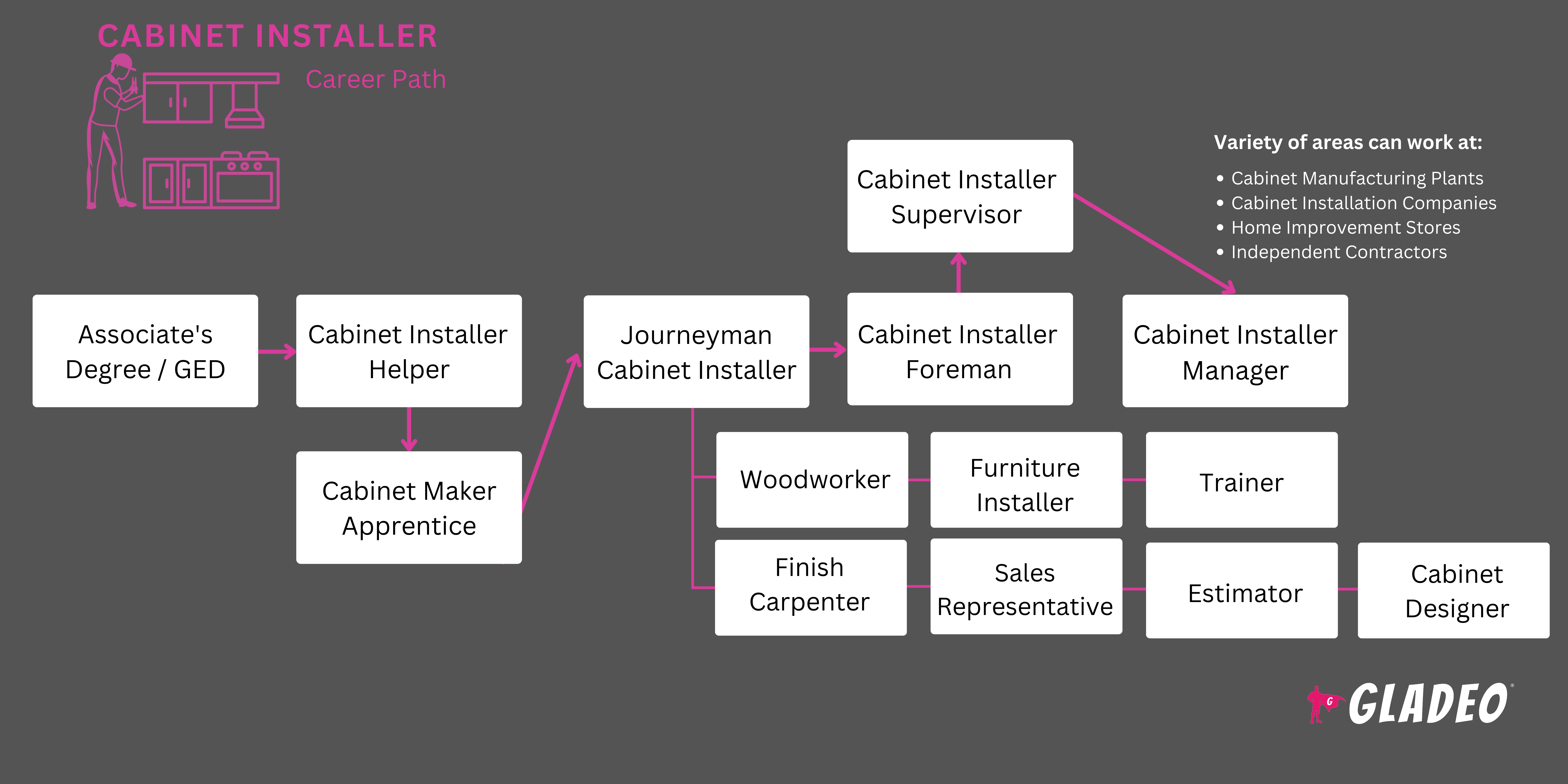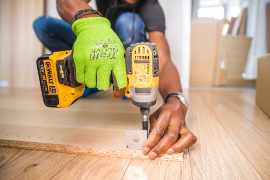Focos
Instalador de cocinas, instalador de carpintería, instalador de ebanistería, técnico de instalación de armarios, instalador de muebles, instalador de sistemas interiores.
¡Imagina vivir en una casa sin armarios! Todos tus vasos, platos, cubiertos, ollas y sartenes, alimentos envasados y otros artículos estarían apilados en el suelo o en cajas. Quizás esa idea te haga darte cuenta de lo importante —y a menudo ignorado— que es el trabajo de los instaladores de armarios.
La instalación de armarios es un oficio especializado que implica la colocación precisa y estable de armarios en todo tipo de edificios. Los instaladores no diseñan ni crean armarios como lo hacen los ebanistas, pero se encargan de la fase final más importante del proceso: la instalación propiamente dicha.
Los instaladores de armarios suelen colaborar con diseñadores, arquitectos y clientes para comprender los requisitos exactos de instalación. De esta forma, pueden planificar con antelación y realizar los ajustes necesarios in situ. Deben dominar diversas técnicas de instalación y ser capaces de utilizar una amplia gama de herramientas manuales, herramientas eléctricas y materiales, al tiempo que garantizan que los armarios se instalen de forma precisa y segura.
- Añadir funcionalidad a los espacios habitables
- Oportunidades para trabajar en una amplia variedad de proyectos.
- Demanda constante de servicios en proyectos de nueva construcción y renovación.
Horario de trabajo
Los instaladores de armarios suelen trabajar a tiempo completo y deben desplazarse con frecuencia a los lugares de trabajo. Pueden tener que hacer horas extras cuando colaboran con equipos de construcción en proyectos de mayor envergadura.
Funciones típicas
- Reunirse con los clientes según sea necesario para revisar el alcance del proyecto, los detalles, los plazos y el presupuesto.
- Prepare presupuestos basados en los costes de materiales, mano de obra, etc. Responda a las preguntas u ofrezca aclaraciones.
- Compartir contratos formales para que el cliente los revise, apruebe y firme.
- Leer e interpretar planos de instalación, planos y hardware necesario.
- Mida y prepare minuciosamente los lugares de instalación. Verifique las dimensiones de las áreas de instalación para asegurarse de que los gabinetes encajen según lo diseñado.
- Tenga en cuenta los accesorios de fontanería, la iluminación, las puertas, los electrodomésticos, etc.
- Instale los armarios, asegurándose de que estén nivelados, bien sujetos y correctamente alineados. Ajuste o modifique los armarios in situ para que encajen perfectamente.
- Utilice diversas herramientas para medir, cortar y fijar durante la instalación.
- Instalar herrajes (como bisagras, manijas, pestillos o tiradores de cajones) utilizando herramientas manuales.
- Realizar retoques en los armarios instalados, si es necesario y se cuenta con la cualificación necesaria.
- Coordinar con los clientes, diseñadores y equipos de construcción durante todo el proceso de instalación.
- Limpiar el lugar de trabajo después de la instalación; devolver el vehículo con el equipo y las herramientas al lugar de trabajo.
- Enviar facturas a los clientes para su pago; responder a cualquier disputa o discrepancia.
Responsabilidades adicionales
- Llevar un control de todos los equipos y herramientas. Realizar el mantenimiento rutinario o las reparaciones necesarias.
- Solicite nuevos equipos, herramientas, hardware u otros suministros cuando sea necesario.
- Mantenga registros precisos de las instalaciones y los materiales utilizados.
- Mantener un entorno de trabajo seguro, cumpliendo con las normas de seguridad.
- Actualizar continuamente las habilidades para incluir las últimas técnicas y herramientas de instalación.
Habilidades sociales
- Precisión
- Analítico
- Orientado a los negocios (si es autónomo)
- Servicio al cliente
- Orientado a los detalles
- Excelente coordinación mano-ojo
- Destreza manual
- Sin alergias graves al polvo ni problemas respiratorios.
- Paciencia
- Perseverancia
- Resolución de problemas
- Gestión de proyectos
- Garantía de calidad
- Con mentalidad de seguridad
- Buen juicio y razonamiento
- Fuertes habilidades de comunicación
Habilidades técnicas
- Técnicas de montaje
- Cálculos matemáticos básicos
- Lectura de planos
- Estimación de materiales y costes
- Técnicas de instalación y montaje, como el trazado y el uso de cuñas.
- Instalación de herrajes (por ejemplo, bisagras, tiradores)
- Conocimiento de la aplicación de adhesivos
- Conocimientos sobre la instalación y el ajuste de guías para cajones.
- Técnicas de diseño y marcado
- Uso adecuado de herramientas manuales (por ejemplo, cinceles, cepillos, sierras) y herramientas eléctricas (por ejemplo, sierra de mesa, sierra de cinta, fresadora).
- Procedimientos de seguridad
- Empresas constructoras
- Empresas constructoras de viviendas
- Contratistas independientes
- Empresas de renovación y remodelación
- Puntos de venta que ofrecen servicios de instalación
- Autónomo
La instalación de armarios es un trabajo de precisión. Los instaladores deben tomarse su tiempo para planificar meticulosamente y hacer bien el trabajo a la primera. Hay un montón de cosas que hay que tener en cuenta, como tomar medidas precisas, calcular la altura del techo, llevar los herrajes adecuados, construir alrededor de las tuberías existentes, tener en cuenta cómo pueden interferir las puertas y planificar cómo pueden afectar los armarios a la iluminación.
Además de todas las tareas que hay que controlar, el trabajo también puede ser físicamente exigente, especialmente cuando el día se alarga. Pero hay poco margen para el error, lo que significa que los instaladores no pueden tomar atajos.
Si el proyecto terminado no es perfecto, podrían tener que volver para arreglar las cosas. De lo contrario, podrían tener que emitir un reembolso, arriesgarse a dañar la reputación de su negocio o incluso ser llevados a un tribunal de reclamaciones menores.
La integración de la tecnología en el diseño de armarios es una tendencia en auge que está transformando la forma en que se instalan y utilizan los armarios.
Las instalaciones modernas suelen incluir estaciones de carga integradas, iluminación activada por sensores y mecanismos avanzados de cierre suave. Estas incorporaciones requieren que los instaladores se mantengan al día en el manejo de dichos componentes y características tecnológicas.
Otra tendencia es la demanda de materiales ecológicos y sostenibles en la fabricación de armarios. Los instaladores de armarios trabajan cada vez más con materiales reciclados, bambú y acabados con bajo contenido en COV. Aunque los instaladores no fabrican los armarios, necesitan saber cómo manejar adecuadamente estos materiales.
También existe una tendencia hacia los armarios personalizados, lo que exige a los instaladores ser un poco más creativos en sus métodos de instalación debido a los tamaños no estándar.
En su juventud, los instaladores de gabinetes pueden mostrar afinidad por las actividades manuales. Es posible que les haya gustado trabajar con madera, hacer manualidades o construir maquetas. Además, es posible que hayan sido muy hábiles en el hogar, reparando artículos domésticos o realizando trabajos ligeros de carpintería. ¡Por lo general, también son muy organizados y excelentes planificadores!
- Los instaladores de armarios deben tener un título de secundaria o equivalente. No es necesario tener un título universitario.
- Tenga en cuenta que alrededor del 17 % de los instaladores terminan completando una licenciatura, pero a menudo es porque quieren perfeccionar sus habilidades empresariales si trabajan por cuenta propia.
- Los trabajadores deben tener habilidades aplicables en carpintería, ebanistería, carpintería o construcción. Estas habilidades se pueden aprender en clases de secundaria, cursos de formación profesional o técnica, programas de aprendizaje, trabajos a tiempo parcial, ¡o una combinación de todas estas cosas!
- Algunos instaladores comienzan como ayudantes u obreros, aprendiendo técnicas de instalación y montaje, instalación de herrajes, aplicación de adhesivos, instalación de guías para cajones, técnicas de diseño y marcado, lectura de planos y uso seguro de herramientas manuales y eléctricas.
- Dado que la instalación de armarios es un negocio, los trabajadores también necesitan habilidades de atención al cliente, habilidades comerciales y habilidades generales para la resolución de problemas.
- Según Zippia, se necesitan entre 6 y 12 meses de formación profesional para convertirse en instalador de armarios.
- La seguridad es una parte integral de esta profesión, por lo que puede ser útil contar con un certificado de fundamentos de seguridad y salud de la OSHA o una tarjeta de formación de 10 horas de la OSHA. Los empleadores suelen explicar los detalles y ayudar a los trabajadores a inscribirse.
- Los instaladores de armarios suelen necesitar un permiso de conducir para desplazarse a los lugares de trabajo.
- Los instaladores de armarios no necesitan ir a la universidad, pero si decides estudiar, ten en cuenta el coste de la matrícula, los descuentos y las oportunidades de becas locales (además de las ayudas federales).
- Piensa en tu horario y flexibilidad a la hora de decidir si matricularte en un programa presencial, online o híbrido. Lo ideal es que puedas realizar tantas prácticas como sea posible en muchos de estos cursos de ebanistería.
- Lee las opiniones de antiguos alumnos y consulta las estadísticas de inserción laboral y los detalles sobre la red de antiguos alumnos del programa.
- Tenga en cuenta que algunos programas de formación pueden tener vínculos con empresas locales.
- Los instaladores de gabinetes deben cursar inglés, arte/diseño, lectura de planos, matemáticas generales (aritmética, fracciones, decimales, ratios, proporciones), geometría, física, dibujo técnico, diseño asistido por ordenador y cursos de carpintería o taller.
- Adquiera habilidades prácticas bajo la supervisión de un profesional que le enseñará a utilizar herramientas manuales y eléctricas de forma segura.
- Los estudiantes de secundaria a menudo pueden asistir simultáneamente a clases en centros de formación profesional o universidades comunitarias. El orientador de tu centro educativo debería poder ofrecerte más detalles al respecto.
- Adquiera experiencia laboral práctica mediante trabajos a tiempo parcial en carpintería o construcción (o mediante programas de aprendizaje o puestos de obrero principiante).
- Prueba a trabajar en algunos armarios de tu garaje para practicar.
- Considera la posibilidad de participar como voluntario en proyectos locales de Hábitat para la Humanidad.
- ¡Amplía tus conocimientos prácticos también a través de clases online!
- Mira vídeos relacionados en canales de YouTube como This Old House.
- Fórmate a través de libros, revistas, blogs y foros de debate sobre ebanistería.
- Pregunte a un instalador de gabinetes en activo si tiene tiempo para concederle una entrevista informativa.
Tenga en cuenta que muchos empleadores en oficios especializados, incluida la instalación de armarios, realizan pruebas de detección de drogas antes de la contratación. Esto se debe a que el uso de herramientas manuales y eléctricas puede ser peligroso, por lo que los empleadores y las compañías de seguros quieren reducir los riesgos. En el caso de los programas de aprendizaje, los sindicatos pueden exigir pruebas de detección de drogas antes del aprendizaje o pruebas aleatorias.

- Acumula tanta experiencia relevante como puedas en la escuela o a través del trabajo voluntario, los trabajos a tiempo parcial o un aprendizaje.
- Echa un vistazo a portales de empleo como Glassdoor, Indeed, USAJOBS o SimplyHired.
- Busca oportunidades de aprendizaje en Apprenticeship.gov.
- Pide ayuda al personal de orientación profesional de tu escuela para redactar tu currículum, realizar simulacros de entrevistas y buscar empleo. ¡Es posible que tengan contactos con sindicatos locales que ofrecen programas de aprendizaje!
- Si solicita un puesto de aprendiz sindical, lea atentamente las instrucciones de solicitud antes de rellenar cualquier formulario.
- Tenga en cuenta que «la mayoría de los sindicatos no esperan que seas un experto en tu sector» cuando solicitas un puesto de aprendiz, señala Indeed.
- Ponte en contacto con tu red de contactos para hacerles saber que estás buscando oportunidades.
- Selecciona cuidadosamente los anuncios de empleo para asegurarte de que cumples con los requisitos.
- Céntrate en tu currículum en las experiencias laborales y académicas relevantes.
- Incluye palabras clave en tu currículum/solicitud, como por ejemplo:
- Lectura de planos
- Fabricación de muebles
- Carpintería
- Servicio de atención al cliente
- Orientado a los detalles
- Herramientas manuales
- Moldeado
- Herramientas eléctricas
- Remodelación
- Sierra
- Carpintería de acabado
- Participa en foros online y haz preguntas sobre orientación profesional.
- Pregunta a tus profesores, supervisores y compañeros si estarían dispuestos a servir como referencias personales.
- Revisa las plantillas de currículum para instaladores de armarios para obtener ideas sobre el formato y la redacción.
- Busca preguntas frecuentes en entrevistas para prepararte para esas entrevistas cruciales.
- ¡Vístete siempre de forma adecuada para tener éxito en las entrevistas de trabajo!
- Prepárese para cumplir con los requisitos previos al empleo.
- Los instaladores de armarios pueden ascender en su carrera realizando un trabajo de alta calidad de forma constante, prestando atención a los detalles, siendo puntuales y estando preparados cada día, y terminando los proyectos a tiempo y dentro del presupuesto.
- Habla con tu supervisor sobre tus objetivos profesionales. Hazle saber que estás dispuesto a realizar cualquier formación que te sugiera tu empresa, como certificaciones especializadas.
- Pregunte sobre el reembolso de la matrícula u otros beneficios educativos patrocinados por el empleador para cubrir sus gastos mientras continúa aprendiendo sobre el oficio.
- Prioriza siempre la seguridad y nunca tomes atajos. ¡Un solo percance o lesión grave podría arruinar toda tu carrera!
- Atrévete a trabajar en proyectos más complejos.
- Supervisar y orientar a los instaladores más nuevos y a otros trabajadores junior. ¡Liderar con el ejemplo!
- Manténgase activo en organizaciones profesionales para aprender cosas nuevas y ampliar su red de contactos.
- Si es necesario, solicita puestos de trabajo que ofrezcan más posibilidades de promoción, o crea tu propia empresa.
Sitios web
- Aprendizaje.gov
- Constructores y contratistas asociados
- Contratistas Generales Asociados de América
- Asociación para la Tecnología de Fabricación
- Conectando oportunidades excepcionales con las habilidades de las mujeres profesionales
- Conexiones profesionales
- Corporación Administrativa Carpenters Southwest
- Instituto de Formación de Carpinteros
- De cascos a cascos de seguridad
- Instituto de Constructores de Viviendas
- Cuerpo de Trabajo
- Asociación Nacional de la Industria de la Remodelación
- Sindicato Nacional de Oficios de la Construcción
- NCCER
- Hermanas en la Hermandad
- Hermandad Unida de Carpinteros y Ebanistas de América
- Hermandad Unida de Carpinteros y Ebanistas de América, Fondo de Formación de Carpinteros
- Carpinteros de los Estados Occidentales
- Colaboración de recursos para la industria maderera
- Alianza Profesional de Carpintería de América del Norte
- Asociación de la Industria de Maquinaria para la Madera
Libros
- Construcción de armarios de cocina: BLP de Taunton: Consejos de expertos de principio a fin, por Udo Schmidt.
- Construcción de armarios de cocina (Vuelta a lo básico), por Skills Institute Press
- Instalación sencilla de armarios de cocina, por Gregory Paolini
La fabricación de armarios se está automatizando cada vez más, pero podría pasar mucho tiempo antes de que el proceso de instalación propiamente dicho pueda automatizarse. Por eso, en los próximos años seguirá habiendo una demanda sólida de instaladores de armarios.
Pero si quieres explorar otras opciones, ¡a continuación te presentamos algunas profesiones relacionadas que puedes considerar!
- Trabajador de mantenimiento de edificios
- Carpintero
- Inspector de obras y edificios
- Obrero de la construcción
- Instalador de paneles de yeso
- Instalador de suelos
- Montador de muebles
- Inspector de viviendas
- Trabajador de aislamiento
- Instalador de modelos
- Especialista en renovaciones
- Techador
- Instalador de sistemas fotovoltaicos solares
- Fabricante e instalador de estructuras metálicas
- Colocador de baldosas y piedras
- Ajustador de máquinas para trabajar la madera
Fuente de noticias

Empleos destacados

Cursos y herramientas en línea

Expectativas salariales anuales
Los nuevos trabajadores comienzan con un salario de alrededor de 57 000 dólares. El salario medio es de 78 000 dólares al año. Los trabajadores con mucha experiencia pueden ganar alrededor de 85 000 dólares.
Expectativas salariales anuales
Los nuevos trabajadores comienzan con un salario de alrededor de 75 000 dólares. El salario medio es de 94 000 dólares al año. Los trabajadores con mucha experiencia pueden ganar alrededor de 127 000 dólares.
Expectativas salariales anuales
Los nuevos trabajadores comienzan con un salario de alrededor de 55 000 dólares. El salario medio es de 66 000 dólares al año. Los trabajadores con mucha experiencia pueden ganar alrededor de 76 000 dólares.
Expectativas salariales anuales
Los nuevos trabajadores comienzan con un salario de alrededor de 64 000 dólares. El salario medio es de 83 000 dólares al año. Los trabajadores con mucha experiencia pueden ganar alrededor de 119 000 dólares.
Expectativas salariales anuales
Los nuevos trabajadores comienzan con un salario de alrededor de 52 000 dólares. El salario medio es de 63 000 dólares al año. Los trabajadores con mucha experiencia pueden ganar alrededor de 75 000 dólares.






